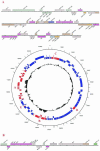Molecular analysis of incHI1 antimicrobial resistance plasmids from Salmonella serovar Typhi strains associated with typhoid fever
- PMID: 12936967
- PMCID: PMC182646
- DOI: 10.1128/AAC.47.9.2732-2739.2003
Molecular analysis of incHI1 antimicrobial resistance plasmids from Salmonella serovar Typhi strains associated with typhoid fever
Abstract
The first outbreak of multidrug-resistant (MDR) typhoid fever in Vietnam was in 1993, and by 1995 nearly 90% of cases were MDR. Plasmid HCM1, sequenced in full, is an incHI1 plasmid from Salmonella enterica serovar Typhi strain CT18, isolated in Vietnam in 1993. Restriction analysis shows that pHCM1 shares a restriction fragment length polymorphism (RFLP) pattern with plasmids isolated from the first outbreak and 10 of 17 MDR plasmids isolated from sporadic cases occurring at the same time in Vietnam. A core region of pHCM1 has significant DNA sequence similarity to plasmid R27, isolated in 1961 from S. enterica in the United Kingdom. There are five regions of DNA in pHCM1 which are not present in R27. Two of these are putative acquisition regions; the largest is 34.955 kbp in length and includes sequences of several antibiotic resistance genes and several insertion sequences. The borders of this region are defined by two identical IS10 left elements, associated with an inversion of DNA or with a truncated Tn10 element. The second, smaller region is 14.751 kbp and carries a trimethoprim resistance gene dfr14A cassette associated with a class 1 integrase. In 1993 to 1994, restriction analysis revealed some variations in the structures of Salmonella serovar Typhi MDR plasmids which were mapped to the two putative acquisition regions and three smaller variable regions. In 1996 a single RFLP type, RFLP7, was found to carry the dfrA7 and sul-1 genes, which were not present on R27 or pHCM1. This plasmid type appears to have a selective advantage over other plasmids with the same resistance phenotype.
Figures



Similar articles
-
The emergence of multidrug resistance to antimicrobial agents for the treatment of typhoid fever.Trans R Soc Trop Med Hyg. 2004 Jul;98(7):423-30. doi: 10.1016/j.trstmh.2003.10.015. Trans R Soc Trop Med Hyg. 2004. PMID: 15138079
-
Multidrug-resistant Salmonella enterica serovar paratyphi A harbors IncHI1 plasmids similar to those found in serovar typhi.J Bacteriol. 2007 Jun;189(11):4257-64. doi: 10.1128/JB.00232-07. Epub 2007 Mar 23. J Bacteriol. 2007. PMID: 17384186 Free PMC article.
-
Genomic signature of multidrug-resistant Salmonella enterica serovar typhi isolates related to a massive outbreak in Zambia between 2010 and 2012.J Clin Microbiol. 2015 Jan;53(1):262-72. doi: 10.1128/JCM.02026-14. Epub 2014 Nov 12. J Clin Microbiol. 2015. PMID: 25392358 Free PMC article.
-
Antimicrobial resistance in Salmonella enterica serovar typhi and paratyphi in South Asia-current status, issues and prospects.Crit Rev Microbiol. 2015;41(4):536-45. doi: 10.3109/1040841X.2014.880662. Epub 2014 Mar 19. Crit Rev Microbiol. 2015. PMID: 24645636 Review.
-
Understanding the Mechanism of Antimicrobial Resistance and Pathogenesis of Salmonella enterica Serovar Typhi.Microorganisms. 2022 Oct 11;10(10):2006. doi: 10.3390/microorganisms10102006. Microorganisms. 2022. PMID: 36296282 Free PMC article. Review.
Cited by
-
The Control of Typhoid Fever in Vietnam.Am J Trop Med Hyg. 2018 Sep;99(3_Suppl):72-78. doi: 10.4269/ajtmh.18-0035. Epub 2018 Jul 24. Am J Trop Med Hyg. 2018. PMID: 30047368 Free PMC article.
-
Multilocus sequence typing analysis of Shigella flexneri isolates collected in Asian countries.J Med Microbiol. 2007 Nov;56(Pt 11):1460-1466. doi: 10.1099/jmm.0.47322-0. J Med Microbiol. 2007. PMID: 17965345 Free PMC article.
-
Link Between Antibiotic Persistence and Antibiotic Resistance in Bacterial Pathogens.Front Cell Infect Microbiol. 2022 Jul 19;12:900848. doi: 10.3389/fcimb.2022.900848. eCollection 2022. Front Cell Infect Microbiol. 2022. PMID: 35928205 Free PMC article. Review.
-
Phylogenetic Analysis Indicates a Longer Term Presence of the Globally Distributed H58 Haplotype of Salmonella Typhi in Southern India.Clin Infect Dis. 2020 Nov 5;71(8):1856-1863. doi: 10.1093/cid/ciz1112. Clin Infect Dis. 2020. PMID: 32003431 Free PMC article.
-
Food Workers as a Reservoir of Extended-Spectrum-Cephalosporin-Resistant Salmonella Strains in Japan.Appl Environ Microbiol. 2020 Jun 17;86(13):e00072-20. doi: 10.1128/AEM.00072-20. Print 2020 Jun 17. Appl Environ Microbiol. 2020. PMID: 32276982 Free PMC article.
References
-
- Acar, J., E. Kaplan, and T. O'Brian. 1997. Monitoring and management of bacterial resistance to antimicrobial agents: a World Health Organization symposium. Clin. Infect. Dis. 24(Suppl. 1):S1-S176. - PubMed
-
- Ausable, F. M., R. Brent, and R. E. Kingston (ed.). 1996. Current protocols in molecular biology. John Wiley and Sons, New York, N.Y.
-
- Cohen, L. C. 1992. Epidemiology of drug resistance: implications for a post-antimicrobial era. Science 257:1050-1055. - PubMed
-
- Connerton, P., J. Wain, T. T. Hien, T. Ali, C. Parry, N. T. Chinh, H. Vinh, V. A. Ho, T. S. Diep, N. P. J. Day, N. J. White, G. Dougan, and J. J. Farrar. 2000. Epidemic typhoid in Vietnam: molecular typing of multiple-antibiotic-resistant Salmonella enterica serotype Typhi from four outbreaks. J. Clin. Microbiol. 38:895-897. - PMC - PubMed
Publication types
MeSH terms
Substances
Grants and funding
LinkOut - more resources
Full Text Sources

